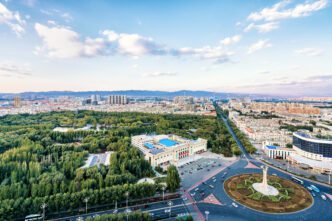Executive Summary
The Story So Far
Why This Matters
Who Thinks What?
Indian Prime Minister Narendra Modi is set to make a rare visit to China this week to attend a summit hosted by Chinese leader Xi Jinping, marking the first such trip since 2018. This diplomatic move signals a potential thawing of relations between the two Asian powers, a shift that analysts suggest has been accelerated by economic pressures from President Donald Trump’s administration, including recent tariffs imposed on Indian imports. The visit comes as the United States has long worked to cultivate India as a key strategic partner to counter China’s growing influence in the Indo-Pacific region.
Geopolitical Realignments and Economic Pressures
Prime Minister Modi’s participation in the Shanghai Cooperation Organization (SCO) summit, a regional security club founded by Moscow and Beijing, represents a significant development. Alongside Modi and Xi, leaders from Russia, Pakistan, Iran, and Central Asia are expected to attend. The timing of the visit, following President Trump’s imposition of tariffs on Indian goods, including those related to its purchases of Russian oil, is seen by some experts as a catalyst for India to stabilize its relationship with Beijing.
Manoj Kewalramani, who heads Indo-Pacific studies at the Takshashila Institution, noted that while Trump’s tariffs “infused a certain amount of urgency,” they were not the sole driver for a reset. Both India and China are reportedly looking to stabilize their relationship based on their own national interests. Yun Sun, director of the China Program at the Stimson Center, suggested that Beijing views this détente as having been “definitely started by Trump,” leading India to recalibrate its foreign policy given perceived shifts in US support.
US Strategy and Regional Dynamics
Successive White House administrations have invested in boosting strategic ties with India through technology transfers and joint military drills, aiming to counter an increasingly assertive China. The prospect of India moving closer to China is viewed as a significant concern for Washington, with analysts describing a loss of India as a counterweight as “the worst outcome” for the United States.
India’s engagement with the China-dominated SCO bloc stands in contrast to its deepening ties with the Quad, a security grouping that includes the US, Japan, and Australia, widely seen as a democratic bulwark against China’s regional influence. This dual engagement underscores India’s policy of strategic autonomy, which prioritizes national interests over strict bloc allegiances.
Historical Tensions and Recent Progress
The relationship between India and China has been historically complex, moving from post-colonial solidarity to strategic rivalry. A brief but brutal conflict in 1962 established a legacy of mistrust and an unresolved border dispute, which remains a primary point of contention. This was further exacerbated by deadly hand-to-hand clashes at their disputed Himalayan border in the Galwan Valley in 2020, which resulted in casualties on both sides.
Despite these tensions, a gradual normalization of ties has been underway. Following a meeting between Modi and Xi on the sidelines of the BRICS summit in Russia last October, both sides have taken steps to improve relations. These include the agreement to restart direct flights, the reopening of pilgrimage sites in Tibet for Indians, and the re-issuance of tourist visas for citizens of both countries.
Economic Imperatives and Lingering Challenges
Economic necessity plays a crucial role in India’s recalibration. Last year, China was India’s second-largest trading partner after the US, with bilateral trade reaching $118 billion. India relies on China not only for finished goods but also for essential intermediate products and raw materials vital for its industries.
However, the economic ties exist under the shadow of a tense military reality. The presence of tens of thousands of troops still deployed at the disputed Himalayan border and the unresolved conflict continue to hinder the full rebuilding of confidence. While both sides recently agreed to 10 points of consensus on their border issue, including maintaining “peace and tranquility,” experts like Tanvi Madan of the Brookings Institution note that it is “not clear that either side will really trust each other.” The true test, she suggests, will be whether rhetoric translates into tangible de-escalation on the ground.
The upcoming summit highlights India’s delicate balancing act between its national interests, economic needs, and strategic partnerships. While a fundamental realignment away from the US is considered unlikely by analysts, the engagement signifies a push for a more stable, albeit still competitive, relationship with its powerful neighbor.








